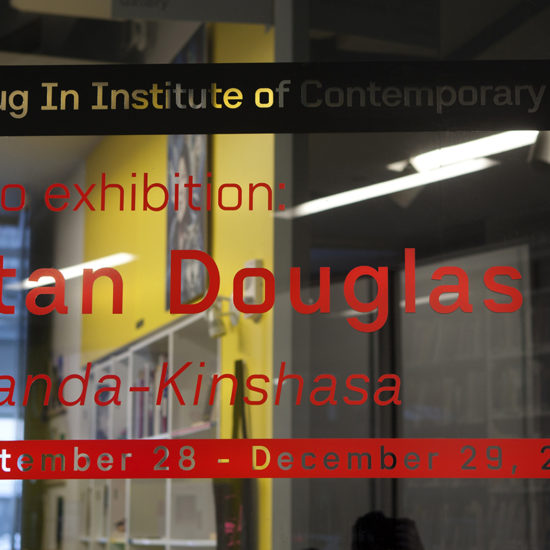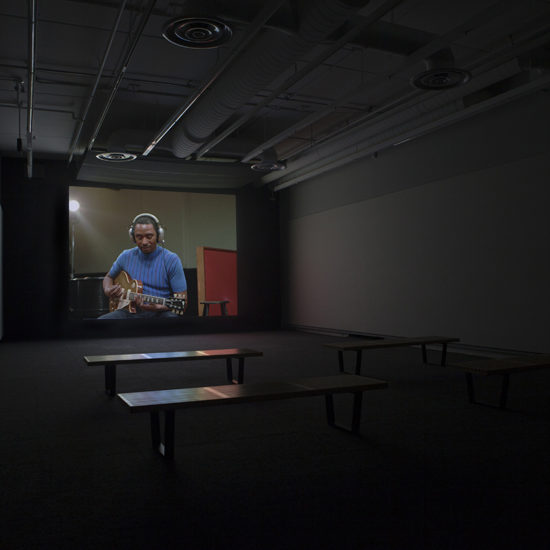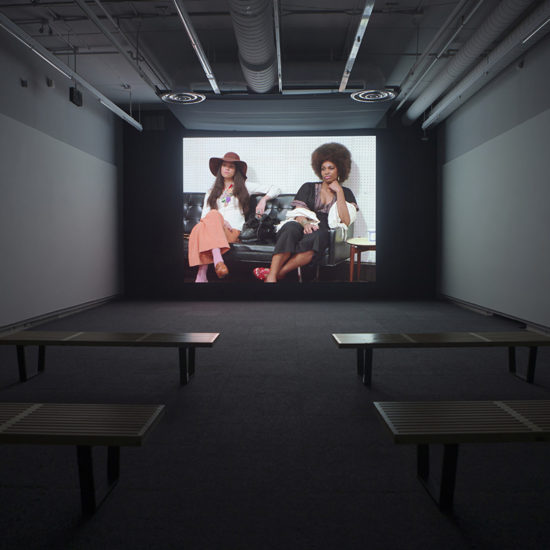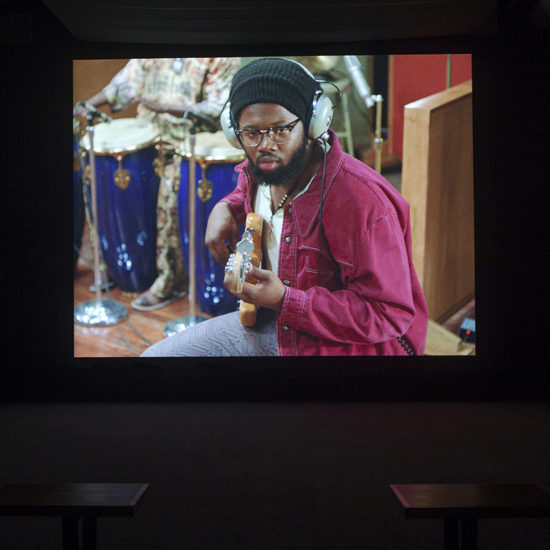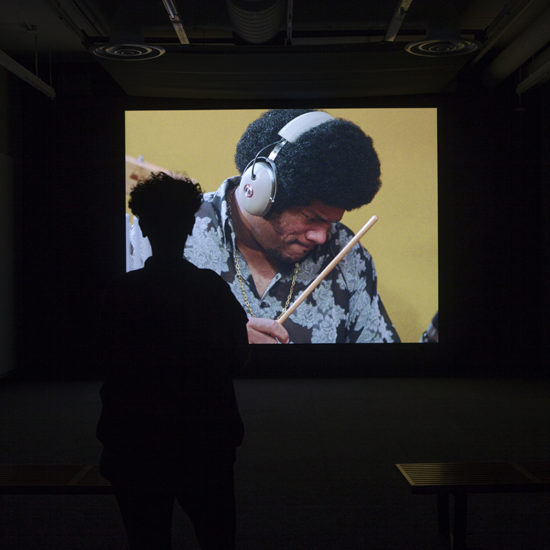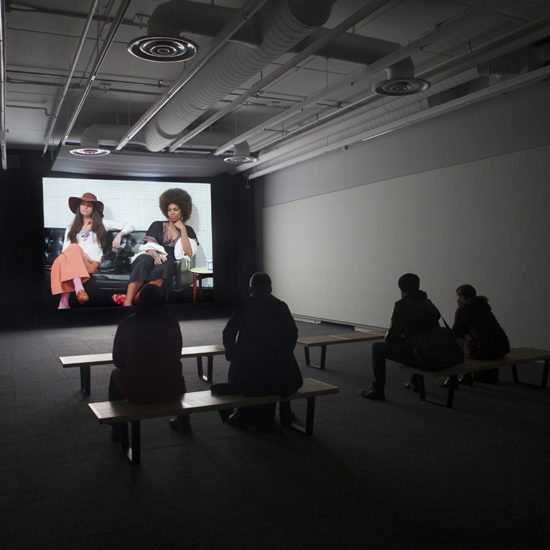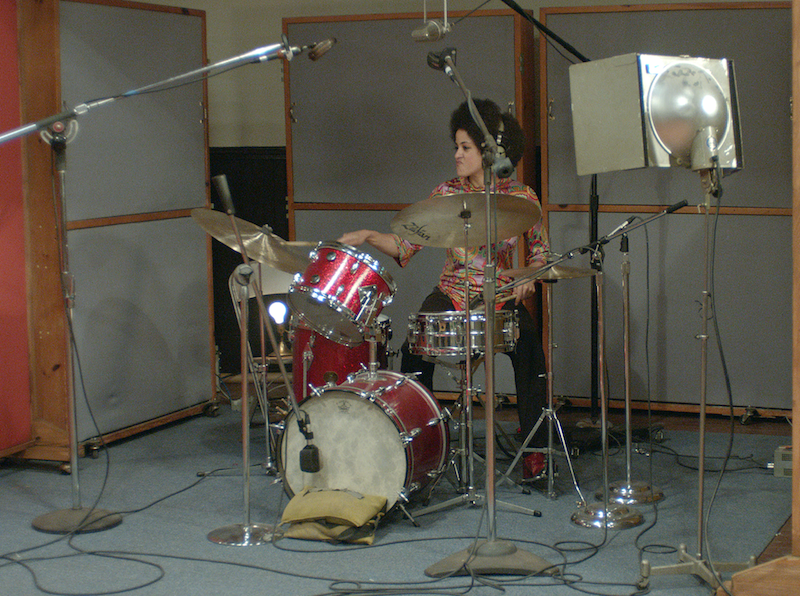
Luanda-Kinshasa by Stan Douglas
September 28, 2019 – December 29, 2019
Opening Reception: Saturday, September 28 | 7 to 11pm
At Plug In ICA in conjunction with Nuit Blanche
Artist Talk by Stan Douglas: Friday, September 27, 2019 | 7pm
Off-site location: 136 Artlab, The School of Art, University of Manitoba
For Luanda-Kinshasa, Stan Douglas deftly reconstructs the legendary Columbia 30th Street Studio. For this epic six-hour video, the lens-based artist has imagined a jam session set in the early seventies in the prestigious Manhattan studio, nick-named “The Church.” Columbia Records retrofitted an abandoned church with vaulted ceilings into a studio that from 1948 to 1981 became the site to some of the most celebrated musical recordings of the twentieth century such as Miles Davis’s On the Corner with a long list of pivotal musicians producing in the studio from Billie Holiday and Thelonious Monk to Aretha Franklin.
Luanda-Kinshasa is a fictional live recording of a seventies jazz-funk band laying down a distinct jazz, funk and Afrobeat mix. The seemingly infinite jam session in Luanda-Kinshasa is not just a fictional depiction, it is an exacting construction. The six-hour set is comprised of edited clips of a much shorter recording session, from which Douglas mixed into a seamless musical assemble that builds and wanes into a controlled post-production synthesis without repeat. It is an inspired feat in sound and image, pushing the limits of both — building a sound that continues to rejuvenate, synced with images that flow naturally. Adding to the illusion of a continuous real-time recording is the subtly phonic foregrounding of an instrument when the camera focuses on the actor playing it.
The musicians are characters that respond to the camera. Working with acclaimed American jazz pianist Jason Moran, Douglas hired a group of musicians, including Moran, to play a jazz-funk band who blend Afro, Asian and Latin motifs into their sound. Douglas has dressed them in patently seventies attire, including their instruments, and added distinct seventies elements and brands to the minutia of cigarette packs and coffee cups. People are also hanging around the sidelines. There are technicians continuously adjusting nobs and such, groupies languidly waiting, and a photographer imposing his camera. But the musicians are the film camera’s focus as its movement and operation animates them. As the camera pans from one musician to the next, the performer comes alive. At times you can see a self-consciousness arise in the performers as the camera moves in and around them, but most often the camera signals a reinvigorated charge in playing. The camera is thus much more than a documentary device, it is an active agent, adding energy to the scene and sound.
The lens is the eye of the artist, directing the action, but it is also a central character; its movements as active and engaged as the performers. The camera is there to capture a story but also to play a part in its referential structure. One direct point of reference is Jean Luc Godard’s film One Plus One from 1968, which is partly set in a sound studio where the Rolling Stones are recording “Sympathy for the Devil.” Montaged between studio scenes are images of the Black Panthers who read from anarchist texts. Other juxtaposing shots show a woman wandering in the woods alone or a group of white women who appear to be kidnapped and are ultimately killed. Godard’s link between popular music and dissonant action is referenced by Douglas in the reconstruction of the studio, which has a familiar look and palette to the one captured by Godard. And most notably, Douglas employs the French director’s erratic panning camera movements. But in Luanda-Kinshasa Douglas focuses the narrative action to one setting and thus distills the revolutionary acts and race politics directly and axiomatically to the musicians and their music in the studio.
Interwoven through much of Douglas’s photographic and film works is a referential politics that delineates Black diaspora linked to colonial appropriation and the assimilation of African culture and music. His cinematic play Helen Lawrence (2014) set as a film noir tale in the thirties in Hogan’s Alley — Vancouver’s first and only Black neighbourhood, which was originally settled by people moving North from the United States in the 1930s and harboured much of the city’s bars and clubs. This now demolished and mostly forgotten district is also the subject of Circa1948 (2014) Douglas’s first and only interactive augmented reality production that imposes narratives over reconstructed images of a precisely rebuilt set of Hogan’s Alley and the Old Vancouver Hotel. For Hors-champ (1992), a video installation, Douglas recreated a French television recording studio, filming four musicians who improvised Albert Aylers’ seminal free jazz composition Spirits Rejoice while also weaving in licks from the French national anthem. The musical reference in this early video installation carries associations with political action in France linked to 1968 riots and the Black Nationalist Movement in the United States. His photographic series Disco Angola (2012) draws links to Portugal’s colonial past, and its relationship to Angola’s struggle for independence. In the title Luanda-Kinshasa Douglas draws geographical ties to the music being played in this marathon jam session to colonial histories and the far-reaching influences of African rhythms into American and European jazz and funk. The title names two African capital cities: Luanda in Angola and Kinshasa in the Democratic Republic of Congo, but the scene is situated in New York.
The geographical setting and social aspect of Luanda-Kinshasa moves beyond representation to activation, where the imagined is pulsating with the real, voicing a racial and gender divide that is present in the reconstructed studio. The scene is a visual idiom for how the west has come to define itself, through its appropriations. But also, as it articulates a moment of control where the actors consciously inform and influence each other, and in Douglas’s hands is transformed into a scenario that continually reconstructs itself into an indiscernible loop. The music, camera, editing process and the technical apparatus for the work’s presentation are pushed to the edge of functionality through control and precision. This deliberate and sustained complexity is imbued with political history and action. What appears a singular and energized jam session contains so much history, drawing links back to the African continent, rooting the tempo, rhythm and performers back to moments in time, and places where independence was being hard fought. In the seventies, the DRC was then the new Zaire and Angola gained independence which stimulated civic war.
The viewer is part of the social scenario, becoming a body in the studio, blending in with those on the sidelines. The jam itself is a spectacle. The musicians skilled and the music complex, lively and upbeat. Douglas captures a mesmerizing performance, but Luanda-Kinshasa is also a challenge to the viewer as Douglas presents an implicated sociality. He demands as much from the viewer as he does of the performers, the camera, himself and his studio.
Jenifer Papararo
The musicians in the video were selected by jazz pianist and composer Jason Moran, who played alongside Kahlil Kwame Bell, Liberty Ellman, Jason Lindner, Abdou Mboup, Nitin Mitta, Antoine Roney, Marvin Sewell, Kimberly Thompson, and Burniss Earl Travis. Other key contributors include producers Christopher Martini and Trivium Films, musical producer and arranger Scotty Hard, director of photography Sam Chase, and production designer Kelly McGehee.
Installation for this exhibition of Luanda-Kinshasa was facilitated by Stan Douglas’s studio work with Linda Chinfen and Brodie Smith with the lead of Plug In ICA Head Preparator Theo Sims along with assistance from Craig Love, Janelle Tougas and Colby Richardson.
Stan Douglas has created films and photographs, and more recently theater productions and other multidisciplinary projects that investigate the parameters of their medium. His ongoing inquiry into technology’s role in image making, and how those mediations infiltrate and shape collective memory has resulted in works that are at once specific in their historical and cultural references and broadly accessible. Photography has been a central focus of Douglas’s practice, utilized at first as a means of preparing for his films and eventually as a powerful pictorial tool in its own right. An alumnus of Emily Carr College of Art in Vancouver in the early 1980s, Douglas was one of the first artists to be represented by David Zwirner, where he had his first American solo exhibition in 1993. In 2013, a major survey of the artist’s work, Stan Douglas: Photographs 2008–2013, was presented at Carré d’Art – Musée d’Art Contemporain in Nîmes, France. Other major solo presentations include those held at Museu Coleção Berardo, Lisbon (2015); The Fruitmarket Gallery, Edinburgh (2014); Minneapolis Institute of Arts (2012); The Studio Museum in Harlem, New York (2005); Serpentine Gallery, London (2002); Centre Georges Pompidou (1994); and Art Gallery of Ontario, (1987). Recently, Douglas participated in La Biennale di Venezia, 58th International Art Exhibition. Douglas has been the recipient of notable awards, including the Hasselblad Foundation International Award in Photography (2016); the third annual Scotiabank Photography Award (2013); and the Infinity Award from the International Center of Photography, New York (2012). He lives and works in Vancouver.



